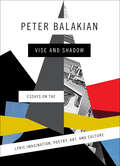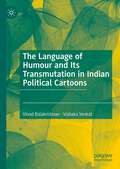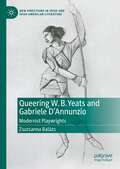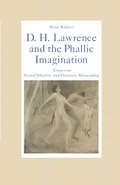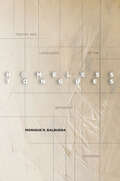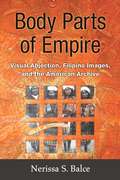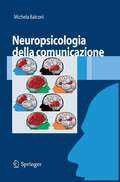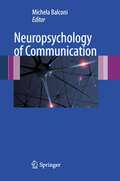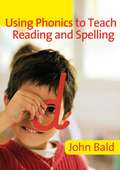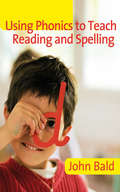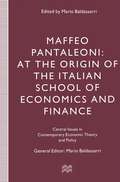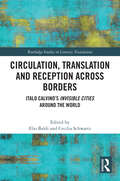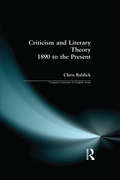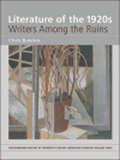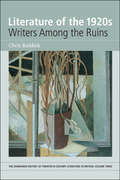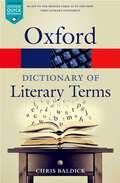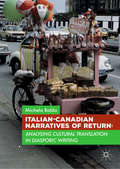- Table View
- List View
Vise and Shadow: Essays on the Lyric Imagination, Poetry, Art, and Culture
by Peter BalakianPeter Balakian is a renowned poet, scholar, and memoirist; but his work as an essayist often prefigures and illuminates all three. "I think of vise and shadow as two dimensions of the lyric (literary and visual) imagination," he writes in the preface to this collection, which brings together essayistic writings produced over the course of twenty-five years. Vise, "as in grabbing and holding with pressure," but also in the sense of the vise-grip of the imagination, which can yield both clarity and knowledge. Consider the vise-grip of some of the poems of our best lyric poets, how language might be put under pressure "as carbon might be put under pressure to create a diamond." And shadow, the second half of the title: both as noun, "the shaded or darker portion of the picture or view or perspective," "partial illumination and partial darkness"; and as verb, to shadow, "to trail secretly as an inseparable companion" or a "force that follows something with fidelity; to cast a dark light on something—a person, an event, an object, a form in nature." Vise and Shadow draws into conversation such disparate figures as W. B. Yeats, Hart Crane, Joan Didion, Primo Levi, Robert Rauschenberg, Bob Dylan, Elia Kazan, and Arshile Gorky, revealing how the lyric imagination of these artists grips experience, "shadows history," and "casts its own type of illumination," creating one of the deepest kinds of human knowledge and sober truth. In these elegantly written essays, Balakian offers a fresh way to think about the power of poetry, art, and the lyrical imagination as well as history, trauma, and memory.
Vise and Shadow: Essays on the Lyric Imagination, Poetry, Art, and Culture
by Peter BalakianPeter Balakian is a renowned poet, scholar, and memoirist; but his work as an essayist often prefigures and illuminates all three. "I think of vise and shadow as two dimensions of the lyric (literary and visual) imagination," he writes in the preface to this collection, which brings together essayistic writings produced over the course of twenty-five years. Vise, "as in grabbing and holding with pressure," but also in the sense of the vise-grip of the imagination, which can yield both clarity and knowledge. Consider the vise-grip of some of the poems of our best lyric poets, how language might be put under pressure "as carbon might be put under pressure to create a diamond." And shadow, the second half of the title: both as noun, "the shaded or darker portion of the picture or view or perspective," "partial illumination and partial darkness"; and as verb, to shadow, "to trail secretly as an inseparable companion" or a "force that follows something with fidelity; to cast a dark light on something—a person, an event, an object, a form in nature." Vise and Shadow draws into conversation such disparate figures as W. B. Yeats, Hart Crane, Joan Didion, Primo Levi, Robert Rauschenberg, Bob Dylan, Elia Kazan, and Arshile Gorky, revealing how the lyric imagination of these artists grips experience, "shadows history," and "casts its own type of illumination," creating one of the deepest kinds of human knowledge and sober truth. In these elegantly written essays, Balakian offers a fresh way to think about the power of poetry, art, and the lyrical imagination as well as history, trauma, and memory.
Vise and Shadow: Essays on the Lyric Imagination, Poetry, Art, and Culture
by Peter BalakianPeter Balakian is a renowned poet, scholar, and memoirist; but his work as an essayist often prefigures and illuminates all three. "I think of vise and shadow as two dimensions of the lyric (literary and visual) imagination," he writes in the preface to this collection, which brings together essayistic writings produced over the course of twenty-five years. Vise, "as in grabbing and holding with pressure," but also in the sense of the vise-grip of the imagination, which can yield both clarity and knowledge. Consider the vise-grip of some of the poems of our best lyric poets, how language might be put under pressure "as carbon might be put under pressure to create a diamond." And shadow, the second half of the title: both as noun, "the shaded or darker portion of the picture or view or perspective," "partial illumination and partial darkness"; and as verb, to shadow, "to trail secretly as an inseparable companion" or a "force that follows something with fidelity; to cast a dark light on something—a person, an event, an object, a form in nature." Vise and Shadow draws into conversation such disparate figures as W. B. Yeats, Hart Crane, Joan Didion, Primo Levi, Robert Rauschenberg, Bob Dylan, Elia Kazan, and Arshile Gorky, revealing how the lyric imagination of these artists grips experience, "shadows history," and "casts its own type of illumination," creating one of the deepest kinds of human knowledge and sober truth. In these elegantly written essays, Balakian offers a fresh way to think about the power of poetry, art, and the lyrical imagination as well as history, trauma, and memory.
Vise and Shadow: Essays on the Lyric Imagination, Poetry, Art, and Culture
by Peter BalakianPeter Balakian is a renowned poet, scholar, and memoirist; but his work as an essayist often prefigures and illuminates all three. "I think of vise and shadow as two dimensions of the lyric (literary and visual) imagination," he writes in the preface to this collection, which brings together essayistic writings produced over the course of twenty-five years. Vise, "as in grabbing and holding with pressure," but also in the sense of the vise-grip of the imagination, which can yield both clarity and knowledge. Consider the vise-grip of some of the poems of our best lyric poets, how language might be put under pressure "as carbon might be put under pressure to create a diamond." And shadow, the second half of the title: both as noun, "the shaded or darker portion of the picture or view or perspective," "partial illumination and partial darkness"; and as verb, to shadow, "to trail secretly as an inseparable companion" or a "force that follows something with fidelity; to cast a dark light on something—a person, an event, an object, a form in nature." Vise and Shadow draws into conversation such disparate figures as W. B. Yeats, Hart Crane, Joan Didion, Primo Levi, Robert Rauschenberg, Bob Dylan, Elia Kazan, and Arshile Gorky, revealing how the lyric imagination of these artists grips experience, "shadows history," and "casts its own type of illumination," creating one of the deepest kinds of human knowledge and sober truth. In these elegantly written essays, Balakian offers a fresh way to think about the power of poetry, art, and the lyrical imagination as well as history, trauma, and memory.
Vise and Shadow: Essays on the Lyric Imagination, Poetry, Art, and Culture
by Peter BalakianPeter Balakian is a renowned poet, scholar, and memoirist; but his work as an essayist often prefigures and illuminates all three. "I think of vise and shadow as two dimensions of the lyric (literary and visual) imagination," he writes in the preface to this collection, which brings together essayistic writings produced over the course of twenty-five years. Vise, "as in grabbing and holding with pressure," but also in the sense of the vise-grip of the imagination, which can yield both clarity and knowledge. Consider the vise-grip of some of the poems of our best lyric poets, how language might be put under pressure "as carbon might be put under pressure to create a diamond." And shadow, the second half of the title: both as noun, "the shaded or darker portion of the picture or view or perspective," "partial illumination and partial darkness"; and as verb, to shadow, "to trail secretly as an inseparable companion" or a "force that follows something with fidelity; to cast a dark light on something—a person, an event, an object, a form in nature." Vise and Shadow draws into conversation such disparate figures as W. B. Yeats, Hart Crane, Joan Didion, Primo Levi, Robert Rauschenberg, Bob Dylan, Elia Kazan, and Arshile Gorky, revealing how the lyric imagination of these artists grips experience, "shadows history," and "casts its own type of illumination," creating one of the deepest kinds of human knowledge and sober truth. In these elegantly written essays, Balakian offers a fresh way to think about the power of poetry, art, and the lyrical imagination as well as history, trauma, and memory.
Vise and Shadow: Essays on the Lyric Imagination, Poetry, Art, and Culture
by Peter BalakianPeter Balakian is a renowned poet, scholar, and memoirist; but his work as an essayist often prefigures and illuminates all three. "I think of vise and shadow as two dimensions of the lyric (literary and visual) imagination," he writes in the preface to this collection, which brings together essayistic writings produced over the course of twenty-five years. Vise, "as in grabbing and holding with pressure," but also in the sense of the vise-grip of the imagination, which can yield both clarity and knowledge. Consider the vise-grip of some of the poems of our best lyric poets, how language might be put under pressure "as carbon might be put under pressure to create a diamond." And shadow, the second half of the title: both as noun, "the shaded or darker portion of the picture or view or perspective," "partial illumination and partial darkness"; and as verb, to shadow, "to trail secretly as an inseparable companion" or a "force that follows something with fidelity; to cast a dark light on something—a person, an event, an object, a form in nature." Vise and Shadow draws into conversation such disparate figures as W. B. Yeats, Hart Crane, Joan Didion, Primo Levi, Robert Rauschenberg, Bob Dylan, Elia Kazan, and Arshile Gorky, revealing how the lyric imagination of these artists grips experience, "shadows history," and "casts its own type of illumination," creating one of the deepest kinds of human knowledge and sober truth. In these elegantly written essays, Balakian offers a fresh way to think about the power of poetry, art, and the lyrical imagination as well as history, trauma, and memory.
The Language of Humour and Its Transmutation in Indian Political Cartoons
by Vinod Balakrishnan Vishaka VenkatThis book develops a model to examine the language of humour, which is multimodal and accounts for the possibility of transmutation of humour as it is performed through editorial cartoons. By transmutation is meant the transition in the language of humour when it crosses its own boundaries to provoke unprecedented reactions resulting in offensiveness, disappointment or hurt sentiment. The transmutability about the language of humour points to its inherently diabolical nature which manifests in the performance of controversial cartoons. The model is built by borrowing theoretical cues from Roman Jakobson, Roland Barthes, George Lakoff and Mark Johnson. The integrated model, then, is developed to examine the cartoons which were recommended for deletion by the Thorat Committee, following a cartoon controversy in India. Through the cartoon analysis, the model discerns the significance of context and temporality in determining the impact of humour. It also examines how the ethics of humour; the blurred lines of political correctness and incorrectness are dictated by the political atmosphere and the power dynamics.
Queering W. B. Yeats and Gabriele D’Annunzio: Modernist Playwrights (New Directions in Irish and Irish American Literature)
by Zsuzsanna BalázsQueering W. B. Yeats and Gabriele D’Annunzio: Modernist Playwrights challenges the general resistance in scholarship and queer studies to approach Yeats and D’Annunzio through a queer lens because of their controversial affiliations with fascism and elitism, their heterosexuality and their venerated canonical status. This book provides the first fully theorised queer and comparative reading of Yeats’s and D’Annunzio’s drama. It offers the novel contention that due to their increasing involvement in queer and feminist subcultures, their plays feature feelings that are associated with queer historiography and generate ideas that began to be theorised by queer studies more than half a century after the composition of the plays. Moreover, it uncovers an alert, subversive and often coded social commentary in eight key dramatic texts by each playwright and at the same time highlights the thus far neglected commonalities between the plays and the queer historical as well as cultural contexts of these two prominent modernists.
D. H. Lawrence and the Phallic Imagination: Essays on Sexual Identity and Feminist Misreading (pdf)
by Peter BalbertHomeless Tongues: Poetry and Languages of the Sephardic Diaspora
by Monique BalbuenaThis book examines a group of multicultural Jewish poets to address the issue of multilingualism within a context of minor languages and literatures, nationalism, and diaspora. It introduces three writers working in minor or threatened languages who challenge the usual consensus of Jewish literature: Algerian Sadia Lévy, Israeli Margalit Matitiahu, and Argentine Juan Gelman. Each of them—Lévy in French and Hebrew, Matitiahu in Hebrew and Ladino, and Gelman in Spanish and Ladino—expresses a hybrid or composite Sephardic identity through a strategic choice of competing languages and intertexts. Monique R. Balbuena's close literary readings of their works, which are mostly unknown in the United States, are strongly grounded in their social and historical context. Her focus on contemporary rather than classic Ladino poetry and her argument for the inclusion of Sephardic production in the canon of Jewish literature make Homeless Tongues a timely and unusual intervention.
Body Parts of Empire: Visual Abjection, Filipino Images, and the American Archive
by Nerissa BalceBody Parts of Empire is a study of abjection in American visual culture and popular literature from the Philippine-American War (1899–1902). During this period, the American national territory expanded beyond its continental borders to islands in the Pacific and the Caribbean. Simultaneously, new technologies of vision emerged for imagining the human body, including the moving camera, stereoscopes, and more efficient print technologies for mass media. Rather than focusing on canonical American authors who wrote at the time of U.S. imperialism, this book examines abject texts—images of naked savages, corpses, clothed native elites, and uniformed American soldiers—as well as bodies of writing that document the goodwill and violence of American expansion in the Philippine colony. Contributing to the fields of American studies, Asian American studies, and gender studies, the book analyzes the actual archive of the Philippine-American War and how the racialization and sexualization of the Filipino colonial native have always been part of the cultures of America and U.S. imperialism. By focusing on the Filipino native as an abject body of the American imperial imaginary, this study offers a historical materialist optic for reading the cultures of Filipino America.
Neuropsicologia della comunicazione
by Michela BalconiLe più recenti acquisizioni della neuropsicologia cognitiva hanno consentito di focalizzare la natura dei processi linguistici e comunicativi, individuando i correlati fisiologici ed anatomici sottostanti alla produzione (encoding) e alla comprensione (decoding) del linguaggio. La prima sezione intende esplorare i paradigmi, i metodi e gli strumenti della neuropsicologia "per" la comunicazione. In particolare viene fornita una sintesi dei più recenti approcci di ricerca e degli strumenti empirici applicati allo studio del processo comunicativo, tra i quali la rilevazione dei correlati fisiologici (indici periferici), cognitivi (indici centrali, tra cui i potenziali evento-correlati), e le rilevazioni mediante neuroimaging (come la risonanza magnetica funzionale). Nella seconda sezione del contributo vengono prese in considerazione le componenti pragmatiche della comunicazione. Recenti modelli hanno focalizzato la propria attenzione su alcuni fenomeni peculiari dello scambio comunicativo che evidenziano il ruolo prioritario del "voler dire" nella comunicazione ordinaria. Specificamente facciamo riferimento ai fenomeni dell’ironia e della comunicazione idiomatica, della metafora e, più in generale, del linguaggio iconico o figurato. Particolare attenzione sarà riservata alle recenti acquisizioni empiriche che hanno sottolineato l’indipendenza delle componenti pragmatiche rispetto al piano prettamente "linguistico". La terza sezione del contributo intende analizzare il piano comunicativo non-verbale, con particolare attenzione alla comunicazione delle emozioni. Più specificamente vengono prese in considerazione le componenti mimiche (volto) e vocali (voce) nell’encoding e nel decoding delle emozioni.
Neuropsychology of Communication
by Michela BalconiIn this volume, the communicative and neuropsychological correlates of daily interactions are discussed. The predominant account on explaining the construction of meaning by humans is the inter-relational perspective, that postulates an intentional convergence of meaning arising as a consequence of the active exchanges between people. The neural correlates of communication were illustrated in the light of new empirical results, considering the main topics of: a) language and language development; b) pragmatics and neuropragmatics of communication; c) neurocognition and the cognitive bases of intentions; d) nonverbal communication and emotion contribution to the communicative systems. New methodological approaches are considered, with particular attention to neuroimaging (such as PET and fMRI) and brain stimulation techniques (as MEG and TMS), as well as their application to the clinical field.
Using Phonics to Teach Reading and Spelling (PDF)
by John BaldIncludes CD-Rom. Times Educational Supplement Star Read!. 'This is an authoritative yet lively and eminently readable book. It is well grounded in both the latest academic theory and experienced hands-on pedagogic practice, and it summarises succinctly the implications of the recent Rose Report, giving a masterly exposition of both synthetic and analytic phonics and their places in the processes of learning to read and spell. Practical and organisational issues are tackled in a most supportive way, with very useful checklists and photocopiable proformas on an accompanying CD. The book also provides an excellent guide to provision for professional development, involving the use of lesson observation and part of the evaluation and planning cycle for CPD. Its style is clear and well signposted with subheadings, case-study boxes to illuminate points, and with aims given at the start of each chapter as well as challenging points for reflection and guides to further reading at the ends. Every staff room should have one!' - Dorothy Latham, Primary Education Consultant, English specialist and author of How Children Learn to Write. 'Synthetic phonics may well be only one tool for teaching reading and spelling, but it is the single most important one' - Ruth Kelly, Education Secretary, March 2006. 'Teachers - and particularly Literacy Co-ordinators or SENCOs - who are enthusiastic about children's learning and about their own professional development will undoubtedly benefit from using this book and CD, with its combination of useful explanation and practical resources to support the implementation of the ideas' - Lorna Gardiner, General Adviser, Foundation Stage, North Eastern Education and Library Board, Northern Ireland. Are you looking for practical advice on how to teach phonics? By giving the reader a basic introduction to teaching reading and spelling using phonics, this book will provide you with easy-to-use ideas for your classrooms. Following on from the recommendations of the Rose Report, the author explains why teaching phonics works, and how to present irregular as well as straightforward features of English. The book: contains practical examples and activities for teachers explains the basis of synthetic and analytic phonics gives advice on choosing the best resources looks at how to help the weakest readers includes a CD Rom with photocopiable resources and INSET materials contains a glossary of key terms. Literacy Co-ordinators, teachers and teaching assistants will find this an invaluable resource.
Using Phonics to Teach Reading & Spelling
by John BaldIncludes CD-Rom Times Educational Supplement Star Read! 'This is an authoritative yet lively and eminently readable book. It is well grounded in both the latest academic theory and experienced hands-on pedagogic practice, and it summarises succinctly the implications of the recent Rose Report, giving a masterly exposition of both synthetic and analytic phonics and their places in the processes of learning to read and spell. Practical and organisational issues are tackled in a most supportive way, with very useful checklists and photocopiable proformas on an accompanying CD. The book also provides and excellent guide to provision for professional development, involving the use of lesson observation and part of the evaluation and planning cycle for CPD. Its style is clear and well signposted with subheadings, case-study boxes to illuminate points, and with aims given at the start of each chapter as well as challenging points for reflection and guides to further reading at the ends. Every staff room should have one!' - Dorothy Latham, Primary Education Consultant, English specialist and author of How Children Learn to Write 'Synthetic phonics may well be only one tool for teaching reading and spelling, but it is the single most important one' - Ruth Kelly, Education Secretary, March 2006 'Teachers - and particularly Literacy Co-ordinators or SENCOs - who are enthusiastic about children's learning and about their own professional development will undoubtedly benefit from using this book and CD, with its combination of useful explanation and practical resources to support the implementation of the ideas' - Lorna Gardiner, General Adviser, Foundation Stage, North Eastern Education and Library Board, Northern Ireland Are you looking for practical advice on how to teach phonics? By giving the reader a basic introduction to teaching reading and spelling using phonics, this book will provide you with easy-to-use ideas for your classrooms. Following on from the recommendations of the Rose Report, the author explains why teaching phonics works, and how to present irregular as well as straightforward features of English. The book: o contains practical examples and activities for teachers o explains the basis of synthetic and analytic phonics o gives advice on choosing the best resources o looks at how to help the weakest readers o includes a CD Rom with photocopiable resources and INSET materials o contains a glossary of key terms Literacy Co-ordinators, teachers and teaching assistants will find this an invaluable resource.
Using Phonics to Teach Reading & Spelling (PDF)
by John BaldIncludes CD-Rom Times Educational Supplement Star Read! 'This is an authoritative yet lively and eminently readable book. It is well grounded in both the latest academic theory and experienced hands-on pedagogic practice, and it summarises succinctly the implications of the recent Rose Report, giving a masterly exposition of both synthetic and analytic phonics and their places in the processes of learning to read and spell. Practical and organisational issues are tackled in a most supportive way, with very useful checklists and photocopiable proformas on an accompanying CD. The book also provides and excellent guide to provision for professional development, involving the use of lesson observation and part of the evaluation and planning cycle for CPD. Its style is clear and well signposted with subheadings, case-study boxes to illuminate points, and with aims given at the start of each chapter as well as challenging points for reflection and guides to further reading at the ends. Every staff room should have one!' - Dorothy Latham, Primary Education Consultant, English specialist and author of How Children Learn to Write 'Synthetic phonics may well be only one tool for teaching reading and spelling, but it is the single most important one' - Ruth Kelly, Education Secretary, March 2006 'Teachers - and particularly Literacy Co-ordinators or SENCOs - who are enthusiastic about children's learning and about their own professional development will undoubtedly benefit from using this book and CD, with its combination of useful explanation and practical resources to support the implementation of the ideas' - Lorna Gardiner, General Adviser, Foundation Stage, North Eastern Education and Library Board, Northern Ireland Are you looking for practical advice on how to teach phonics? By giving the reader a basic introduction to teaching reading and spelling using phonics, this book will provide you with easy-to-use ideas for your classrooms. Following on from the recommendations of the Rose Report, the author explains why teaching phonics works, and how to present irregular as well as straightforward features of English. The book: o contains practical examples and activities for teachers o explains the basis of synthetic and analytic phonics o gives advice on choosing the best resources o looks at how to help the weakest readers o includes a CD Rom with photocopiable resources and INSET materials o contains a glossary of key terms Literacy Co-ordinators, teachers and teaching assistants will find this an invaluable resource.
Maffeo Pantaleoni: At the Origin of the Italian School of Economics and Finance (Central Issues in Contemporary Economic Theory and Policy)
by Mario BaldassarriThis collection of papers proposes to trace the professional and personal fortunes of Maffeo Pantaleoni (1857-1924), an eminent and controversial Italian economist from the liberalist culture which in the early twentieth century perceived the shortcomings and dangers of the nascent monopolist concentrations. He was one of the founders of what we can today call the Italian school of economics and finance. These contributions examine his life, thought and works and his reputation since his death. His vital influence on economic history.
Circulation, Translation and Reception Across Borders: Italo Calvino’s Invisible Cities Around the World (Routledge Studies in Literary Translation)
by Elio Baldi Cecilia SchwartzThis volume offers a detailed analysis of selected cases in the reception, translation and artistic reinterpretation of Italo Calvino's Invisible Cities (1972) around the world. The book traces the many different ways in which Calvino's modern classic has been read, translated and adapted in Brazil, France, the Netherlands and Flanders, Mexico, Romania, Scandinavia, the USSR, China, Poland, Japan and Australia. It also offers analyses of the relation between Calvino's book and, respectively, the East and Africa, as well as reflections on the book's inspiration for, and resonance in, dance, architecture and art. The volume thus traces the diversity in the reception and circulation of Invisible Cities in different countries and continents, offering a much wider framework for the discussion of Calvino’s masterpiece than before, and a more detailed picture of its cultural and linguistic ramifications. This book will be of interest to scholars in Comparative Literature, World Literature, Translation Studies, Italian Studies, Romance Languages, European Studies, Dance, Architecture and Media Studies, as well as to scholars specialised in paratext and reception.
Circulation, Translation and Reception Across Borders: Italo Calvino’s Invisible Cities Around the World (Routledge Studies in Literary Translation)
by Elio Baldi Cecilia SchwartzThis volume offers a detailed analysis of selected cases in the reception, translation and artistic reinterpretation of Italo Calvino's Invisible Cities (1972) around the world. The book traces the many different ways in which Calvino's modern classic has been read, translated and adapted in Brazil, France, the Netherlands and Flanders, Mexico, Romania, Scandinavia, the USSR, China, Poland, Japan and Australia. It also offers analyses of the relation between Calvino's book and, respectively, the East and Africa, as well as reflections on the book's inspiration for, and resonance in, dance, architecture and art. The volume thus traces the diversity in the reception and circulation of Invisible Cities in different countries and continents, offering a much wider framework for the discussion of Calvino’s masterpiece than before, and a more detailed picture of its cultural and linguistic ramifications. This book will be of interest to scholars in Comparative Literature, World Literature, Translation Studies, Italian Studies, Romance Languages, European Studies, Dance, Architecture and Media Studies, as well as to scholars specialised in paratext and reception.
Criticism and Literary Theory 1890 to the Present (Longman Literature In English Series)
by Chris BaldickPresents a coherent and accessible historical account of the major phases of British and American Twentieth-century criticism, from 'decadent' aestheticism to feminist, decontsructonist and post-colonial theories. Special attention is given to new perspectives on Shakesperean criticism, theories of the novel and models of the literary canon. The book will help to define and account for the major developments in literary criticism during this century exploring the full diversity of critical work from major critics such as T S Eliot and F R Leavis to minor but fascinating figures and critical schools. Unlike most guides to modern literary theory, its focus is firmly on developments within the English speaking world.
Criticism and Literary Theory 1890 to the Present (Longman Literature In English Series)
by Chris BaldickPresents a coherent and accessible historical account of the major phases of British and American Twentieth-century criticism, from 'decadent' aestheticism to feminist, decontsructonist and post-colonial theories. Special attention is given to new perspectives on Shakesperean criticism, theories of the novel and models of the literary canon. The book will help to define and account for the major developments in literary criticism during this century exploring the full diversity of critical work from major critics such as T S Eliot and F R Leavis to minor but fascinating figures and critical schools. Unlike most guides to modern literary theory, its focus is firmly on developments within the English speaking world.
Literature of the 1920s: Volume 3
by Chris BaldickEclipsed until now by the dominant story of Modernism, a much more inclusive range of 1920s literature emerges freshly illuminated in Chris Baldick’s approachable history. The Twenties are reclaimed here as a period with its own distinctive historical awareness and creative agenda, one in which Modernist and non-Modernist currents are shown to engage with common memories and preoccupations. Spanning many genres high and low, including war memoirs, critical essays and detective stories as well as drama, poetry and the novel, Baldick's account situates leading works and authors of the decade – Eliot, Woolf, Lawrence, Huxley, Coward and others - among a rich array of their lesser-known contemporaries to discover common obsessions - especially with the now ‘lost’ world of pre-War Britain - and shared moods of elegiac despair, nervous frivolity and bold irreverence.
Literature of the 1920s: Volume 3 (The Edinburgh History of Twentieth-Century Literature in Britain)
by Chris BaldickThe first general account of Twenties literature in Britain
The Oxford Dictionary of Literary Terms (Oxford Quick Reference)
by Chris BaldickThe bestselling Oxford Dictionary of Literary Terms provides clear and concise definitions of the most troublesome literary terms, from abjection to zeugma. It is an essential reference tool for students of literature in any language. Now expanded and in its fourth edition, it includes increased coverage of new terms from modern critical and theoretical movements, such as feminism, schools of American poetry, Spanish verse forms, life writing, and crime fiction. It includes extensive coverage of traditional drama, versification, rhetoric, and literary history, as well as updated and extended advice on recommended further reading and a pronunciation guide to more than 200 terms. Completely revised and updated, this edition also features brand-new entries on terms such as distant reading, graphic novels, middle generation, and misery memoir. Many new bibliographies have been added to entries and recommended web links are available via a companion website.
Italian-Canadian Narratives of Return: Analysing Cultural Translation in Diasporic Writing
by Michela BaldoThis book examines the concept of translation as a return to origins and as restitution of lost narratives, and is based on the idea of diaspora as a term that depicts the longing to return home and the imaginary reconstructions and reconstitutions of home by migrants and translators. The author analyses a corpus made up of novels and a memoir by Italian-Canadian writers Mary Melfi, Nino Ricci and Frank Paci, examining the theme of return both within the writing itself and also in the discourse surrounding the translations of these works into Italian. These ‘reconstructions’ are analysed through the lens of translation, and more specifically through the notion of written code-switching, understood here as a fictional tool which symbolizes the translational movements between different points of view. This book will be of particular interest to students and scholars of translation and interpreting, migration studies, and Italian and diasporic writing.
